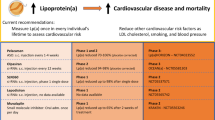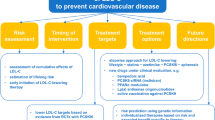Abstract
Elevated triglycerides and low high-density lipoprotein (HDL) levels are more important coronary risk factors in women, and elevated low-density lipoprotein (LDL) levels less important in women, than men. There is clear-cut evidence in clinical trials that the benefit of cholesterol lowering in women and men is virtually identical.
Modifiers of lipids and lipoproteins in women include diabetes mellitus, body-weight and its distribution, and menopausal status. Diabetes is a more powerful predictor of risk in women than men. This may relate to the importance of elevated triglycerides as a risk factor in women, and to the effects of lipoprotein glycosylation, which lead to increased susceptibility to arterial deposition of LDL and decreased reverse cholesterol transport with HDL.
Therapy for lipoprotein disorders in women and men is identical. For the overwhelming majority of patients, treatment with statin therapy is both highly efficacious and well tolerated.

Similar content being viewed by others
References
Bass KM, Newschaffer CJ, Klag MJ, et al. Plasma lipoprotein levels as predictors of cardiovascular death in women. Arch Intern Med 1993; 153: 2209–16
LaRosa JC. Triglycerides and coronary risk in women and the elderly. Arch Intern Med 1997; 157: 961–8
LaRosa JC. The pharmacology and effectiveness of specific lipid-active drugs: estrogen/sex steroids. Coron Artery Dis 1996; 7: 683–8
Kannel WB. Nutrition and the occurrence and prevention of cardiovascular disease in the elderly. Nutr Rev 1984; 46: 68–78
World Health Organization. Japan outscores USA in longevity ranking. USA Today 2000 June 5; Sect. D: 6
Manolio TA, Pearson TA, Wenger NK, et al. Cholesterol and heart disease in older persons and women: review of an NHLBI workshop. Ann Epidemiol 1992; 2: 161–76
LaRosa JC. Cholesterol agonistics. Ann Intern Med 1996; 124: 505–8
LaRosa JC, He J, Vupputuri S. Effects of statins on risk of coronary disease: a meta-analysis of randomized controlled trials. JAMA 1999; 282: 2340–6
Sandkamp M, Assmann G. Lipoprotein(a) in PRO-CAM participants and young myocardial infarction survivors. In: Scanu AM, editor. Lipoprotein(a). New York (NY): Academic Press, 1990: 205–9
Brewer HB. Effectiveness of diet and drugs in the treatment of patients with elevated Lp(a) levels. In: Scanu AM, editor. Lipoprotein(a). New York: Academic Press, 1990: 211–20
Krolewski AS, Warram JH, Valsania P, et al. Evolving natural history of coronary artery disease in diabetes mellitus. Am J Med 1991; 90(2A): 56S–61S
Verges BL. Dyslipidaemia in diabetes mellitus: review of the main lipoprotein abnormalities and their consequences on the development of atherogenesis. Diabetes Metab 1999; 25(S3): 32–40
Soler JT, Folsom AR, Kushi LH, et al. Association of body fat distribution with plasma lipids, lipoproteins, apolipoproteins A-1 and B in postmenopausal women. J Clin Epidemiol 1988; 41: 1075–81
Lapidus L, Bengtsson C, Larsson B, et al. Distribution of adipose tissue and risk of cardiovascular disease and death: a 12-year follow-up of participants in the population study of women in Gothenburg, Sweden. BMJ 1984; 289: 1257–61
Grodin JM, Siiteri PK, MacDonald PC. Source of estrogen production in postmenopausal women. J Clin Endocrinol Metab 1973; 36: 207–14
Barnard RJ. Effects of life-style modification on serum lipids. Arch Intern Med 1991; 151: 1389–94
Bush TL. The epidemiology of cardiovascular disease in postmenopausal women. Ann N Y Acad Sci 1990; 592: 263–71
van der Schouw YT, van der Graaf Y, Steyerberg EW, et al. Age at menopause as a risk factor for cardiovascular mortality. Lancet 1996; 347: 714–8
PEPI Investigators. Effects of estrogen or estrogen-progestin regimens on heart disease risk factors in postmenopausal women: the Postmenopausal Estrogen/Progestin Interventions (PEPI) Trial. JAMA 1995; 273: 199–208
Adams MR, Register TC, Golden DL, et al. Medroxyprogesterone acetate antagonizes inhibitory effects of conjugated equine estrogens on coronary artery atherosclerosis. Arterioscler Thromb Vasc Biol 1997; 17: 217–21
Psaty BM, Heckbert SR, Atkins D, et al. The risk of myocardial infarction associated with the combined use of estrogens and progestins in postmenopausal women. Arch Intern Med 1994; 154: 1333–9
Hulley S, Grady D, Bush T, et al., for the Heart and Estrogen/progestin Replacement Study (HERS) Research Group. Randomized trial of estrogen plus progestin for secondary prevention of coronary heart disease in postmenopausal women. JAMA 1998; 280: 605–13
Herrington DM, Reboussin DM, Brosnihan KB, et al. Effects of estrogen replacement on the progression of coronary-artery atherosclerosis. N Engl J Med 2000; 343: 522–9
Wood D, De Backer G, Faergeman O, et al., and Task Force Members. Prevention of coronary heart disease in clinical practice. Eur Heart J 1998; 19: 1434–503
Expert Panel on Detection, Evaluation, and Treatment of High Blood Cholesterol in Adults. Executive summary of the third report of the National Cholesterol Education Program (NCEP) Expert Panel on Detection, Evaluation, and Treatment of High Blood Cholesterol in Adults (Adult Treatment Panel III). JAMA 2001; 285: 2486–97
Robins SJ, Collins D, Wittes JT, et al., for the VA-HIT Study Group. Relation of gemfibrozil treatment and lipid levels with major coronary events. JAMA 2001; 285: 1585–91
BIP Study Group. Secondary prevention by raising HDL cholesterol and reducing triglycerides in patients with coronary artery disease: the Bezafibrate Infarction Prevention (BIP) study. Circulation 2000; 102: 21–7
Mensink RP, Katan MB. Effect of monounsaturated fatty acids versus complex carbohydrates on high-density lipoproteins in healthy men and women. Lancet 1987; 8525: 122–5
Masarei JRL, Rouse IL, Lynch WJ, et al. Effects of a lacto-ovo vegetarian diet on serum concentration of cholesterol, triglyceride, HDL-C, HDL2-C, HDL3-C, apoprotein-B, and Lp(a). Am J Clin Nutr 1984; 40: 468–78
Ernst N, Bowen P, Fisher M, et al. Changes in plasma lipids and lipoproteins after a modified fat diet. Lancet 1980; I: 111–3
Lokey EA, Tran ZV. Effects of exercise training on serum lipid and lipoprotein concentrations in women: a meta-analysis. Int J Sports Med 1989; 10: 424–9
Hartung GH, Moore CE, Mitchell R, et al. Relationship of menopausal status and exercise level to HDL cholesterol in women. Exp Aging Res 1984; 10: 13–8
Knopp RH. Drug treatment of lipid disorders. N Engl J Med 1999; 341: 498–511
Acknowledgements
No sources of funding were used to assist in the preparation of this manuscript. The author has no conflicts of interest that are directly relevant to the content of this manuscript.
Author information
Authors and Affiliations
Corresponding author
Rights and permissions
About this article
Cite this article
LaRosa, J.C. Outcomes of Lipid-Lowering Treatment in Postmenopausal Women. Drugs Aging 19, 595–604 (2002). https://doi.org/10.2165/00002512-200219080-00005
Published:
Issue Date:
DOI: https://doi.org/10.2165/00002512-200219080-00005




